The distribution substation market is estimated to be valued at USD 44.1 billion in 2025 and is projected to reach USD 65.3 billion by 2035, registering a compound annual growth rate (CAGR) of 4.0% over the forecast period.
The absolute dollar opportunity over this period is USD 21.2 billion, representing the additional revenue potential from 2025 to 2035. This steady growth reflects increasing investments in electricity distribution infrastructure and the modernization of power networks. Companies can capitalize on this opportunity by expanding manufacturing capacity, enhancing service and maintenance offerings, and targeting high-growth regions. The incremental market expansion provides a clear financial incentive for strategic investment and long-term planning. From a business perspective, the USD 21.2 billion absolute dollar opportunity highlights substantial revenue potential for both new entrants and established players.
With the market gradually increasing from USD 44.1 billion in 2025 to USD 65.3 billion in 2035 at a CAGR of 4.0%, firms can plan phased investments and scale operations strategically. By focusing on high-demand regions, optimizing supply chains, and improving project execution capabilities, stakeholders can capture incremental revenue. This predictable growth trajectory allows companies to strengthen market positioning, expand client base, and achieve sustained profitability over the ten-year period.
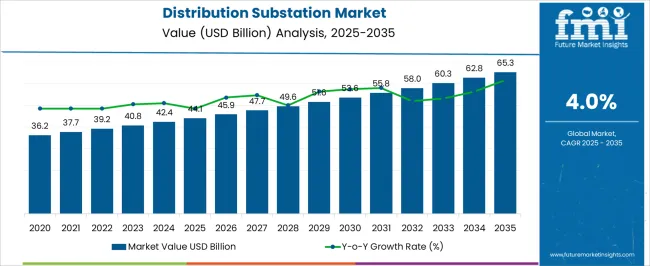
| Metric | Value |
|---|---|
| Distribution Substation Market Estimated Value in (2025 E) | USD 44.1 billion |
| Distribution Substation Market Forecast Value in (2035 F) | USD 65.3 billion |
| Forecast CAGR (2025 to 2035) | 4.0% |
A breakpoint analysis for the distribution substation market highlights key thresholds where growth accelerates or strategic adjustments are required. With the market valued at USD 44.1 billion in 2025 and projected to reach USD 65.3 billion by 2035 at a CAGR of 4.0%, early breakpoints occur around USD 49.6–51.6 billion. These levels represent the initial phase of notable market expansion, reflecting rising investments in power distribution infrastructure and network modernization. Recognizing these breakpoints allows companies to prioritize capacity expansion, optimize project execution, and strengthen supply chains to capture incremental revenue during periods of accelerated growth.
Later-stage breakpoints appear between USD 58.0–62.8 billion as the market approaches maturity and competition intensifies. Surpassing these thresholds may require firms to refine pricing strategies, enhance operational efficiency, and strengthen client engagement to maintain growth momentum. Monitoring these breakpoints enables companies to anticipate shifts in demand and adjust production, project planning, and service strategies accordingly. By aligning strategic actions with these critical thresholds, stakeholders can maximize revenue potential, reinforce market positioning, and navigate the steady growth trajectory from 2025 to 2035 with informed precision.
The market is experiencing robust growth driven by increasing demand for modernized electrical grids and the integration of smart grid technologies. The market's current trajectory reflects a strong shift toward digital solutions that enhance operational efficiency, reliability, and real-time monitoring capabilities.
Investments in upgrading aging infrastructure, the need for improved energy management, and regulatory support for grid modernization are significant factors shaping this growth. Additionally, the rise of distributed energy resources and renewable integration is accelerating the adoption of advanced distribution substations capable of handling complex grid dynamics.
Future opportunities are expected to emerge from expanding urbanization, increasing electricity consumption, and the transition toward smarter, more resilient energy systems globally These factors collectively position the Distribution Substation market for sustained expansion in the coming years.
The distribution substation market is segmented by technology, component, voltage level, category, end use, and geographic regions. By technology, distribution substation market is divided into digital and conventional. In terms of component, distribution substation market is classified into substation automation system, communication network, electrical system, monitoring & control system, and others. Based on voltage level, distribution substation market is segmented into new and refurbished. By category, distribution substation market is segmented into new and refurbished. By end use, distribution substation market is segmented into utility and industrial. Regionally, the distribution substation industry is classified into North America, Latin America, Western Europe, Eastern Europe, Balkan & Baltic Countries, Russia & Belarus, Central Asia, East Asia, South Asia & Pacific, and the Middle East & Africa.
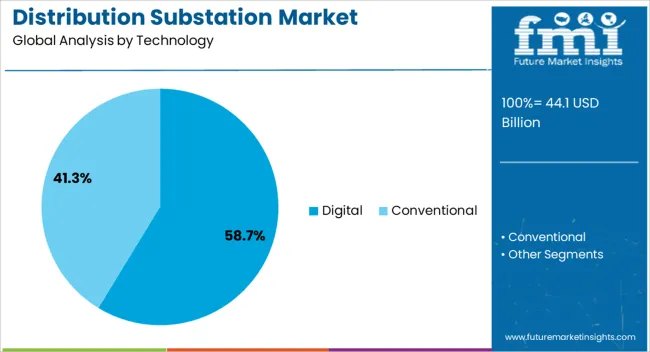
The digital technology segment is projected to hold 58.7% of the distribution substation market revenue share in 2025, establishing it as the dominant technology category. This prominence is attributed to the increasing implementation of digital communication protocols, intelligent electronic devices, and advanced monitoring systems that enhance grid automation and control.
The transition from traditional analog systems to digital platforms enables improved data accuracy, faster fault detection, and remote management capabilities. Additionally, digital technology supports the integration of renewable energy sources and facilitates real-time analytics, which are crucial for modern power distribution networks.
The segment’s growth has been further propelled by ongoing regulatory frameworks encouraging grid modernization and investment in smart grid infrastructure to ensure stable and efficient electricity supply.

The substation automation system component is expected to capture 42.5% of the market revenue share in 2025, marking it as the leading component segment. The expansion of this segment is being driven by the increasing deployment of automation technologies that enable enhanced monitoring, control, and protection of distribution substations.
Automation systems reduce operational costs by minimizing manual interventions and improving fault response times. Their ability to integrate with advanced communication networks allows for seamless coordination with control centers and distributed energy resources.
Growing demand for enhanced reliability and system flexibility in power distribution has reinforced the adoption of substation automation solutions, making this segment a critical growth driver within the market.
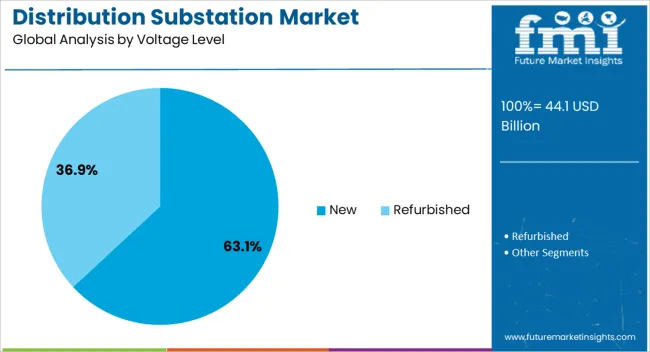
The new voltage level segment is anticipated to account for 63.1% of the market revenue share in 2025, reflecting its significant role in driving market growth. This dominance is influenced by increasing investments in new substation installations aimed at accommodating rising electricity demand and expanding distribution networks.
The deployment of substations at new voltage levels supports improved grid stability and the integration of decentralized power generation sources. Furthermore, advancements in equipment design and materials have enhanced the efficiency and safety of new voltage level substations.
As utilities focus on expanding and modernizing infrastructure to meet future energy needs, the new voltage level segment is positioned to sustain its market leadership due to its critical role in facilitating these upgrades.
The distribution substation market is growing due to increasing electricity demand, renewable energy integration, and urban infrastructure expansion. North America and Europe lead with advanced, automated substations for reliable power distribution and grid modernization. Asia-Pacific shows rapid growth driven by electrification projects, industrial expansion, and smart grid initiatives. Manufacturers differentiate through substation type, automation level, reliability, and safety features. Regional differences in regulatory frameworks, grid infrastructure, and investment capacity influence adoption, project planning, and market competitiveness across industrial, commercial, and residential applications.
Distribution substations vary in type air-insulated, gas-insulated, or hybrid and voltage capacity, impacting performance and deployment. Europe and North America favor automated, gas-insulated substations for urban and industrial grids to maximize reliability, safety, and space efficiency. Asia-Pacific often deploys cost-effective air-insulated substations for rapid expansion and rural electrification projects. Differences in type and voltage influence operational efficiency, maintenance requirements, and installation costs. Leading global suppliers offer advanced, high-voltage, automated substations, while regional manufacturers focus on standard, budget-friendly units. These contrasts shape adoption, project planning, and competitiveness across developed and emerging regions.
Integration of automation, remote monitoring, and SCADA systems enhances substation operational efficiency. North America and Europe prioritize smart substations with real-time fault detection, predictive maintenance, and automated switching to reduce downtime and energy losses. Asia-Pacific adoption focuses on basic automation and centralized control, often balancing cost and functionality. Differences in automation affect reliability, response times, and grid performance. Suppliers offering highly automated, data-driven solutions gain advantages in premium urban and industrial projects, while regional providers meet large-scale, cost-sensitive deployment needs. Automation contrasts directly influence regional adoption, operational efficiency, and long-term system sustainability.
Compliance with electrical safety, environmental, and grid reliability standards is critical for distribution substation deployment. Europe and North America enforce stringent regulations requiring certified, high-performance substations with advanced protection and monitoring systems. Asia-Pacific regulations vary, with emerging markets focusing on standard safety compliance and cost-effective solutions. Differences in regulatory adherence affect project approvals, procurement decisions, and liability risk. Suppliers providing certified, regulation-compliant substations gain access to high-value contracts, while regional manufacturers target budget-conscious projects. Regulatory contrasts influence adoption speed, market accessibility, and competitive positioning globally.
Distribution substations are supplied through OEMs, EPC contractors, and utility partnerships. Europe and North America rely on direct sales, long-term utility contracts, and turnkey installation with technical support. Asia-Pacific uses regional distributors, local suppliers, and government-backed procurement for rapid electrification and industrial projects. Differences in distribution networks affect availability, installation efficiency, and after-sales service. Leading suppliers offer integrated solutions with training and maintenance, while regional manufacturers focus on cost-efficient accessibility. Distribution contrasts shape adoption, customer satisfaction, and long-term market growth across residential, commercial, and industrial electricity networks.

| Country | CAGR |
|---|---|
| China | 5.4% |
| India | 5.0% |
| Germany | 4.6% |
| France | 4.2% |
| UK | 3.8% |
| USA | 3.4% |
| Brazil | 3.0% |
The global distribution substation market was projected to grow at a 4.0% CAGR through 2035, driven by demand in power distribution, utility infrastructure, and industrial energy management applications. Among BRICS nations, China recorded 5.4% growth as large-scale production and deployment facilities were commissioned and compliance with electrical and safety standards was enforced, while India at 5.0% growth saw expansion of manufacturing units to meet rising regional demand. In the OECD region, Germany at 4.6% maintained substantial output under strict industrial and energy regulations, while the United Kingdom at 3.8% relied on moderate-scale operations for urban and industrial power distribution projects. The USA, expanding at 3.4%, remained a mature market with steady demand across utility, industrial, and commercial segments, supported by adherence to federal and state-level quality and safety standards. This report includes insights on 40+ countries; the top five markets are shown here for reference.
Distribution substation market in China is growing at a CAGR of 5.4%. Between 2020 and 2024, growth was driven by rising electricity demand, urbanization, and government investments in smart grid and power distribution infrastructure. Manufacturers focused on advanced, durable, and efficient substation equipment including transformers, switchgears, and protection systems. Expansion of industrial and residential power networks supported adoption across urban and semi-urban areas. In the forecast period 2025 to 2035, growth is expected to accelerate with deployment of digital, IoT-enabled, and energy-optimized substations integrated with renewable energy sources. Policy support, infrastructure modernization, and rising industrial electricity demand will further boost market growth. China remains a global leader due to large population, rapid urbanization, and strong government-backed power distribution initiatives.
Distribution substation market in India is growing at a CAGR of 5.0%. Historical period 2020 to 2024 saw growth supported by rising urban and industrial electricity demand, government investments in smart grids, and expansion of renewable energy networks. Manufacturers focused on cost-effective, reliable, and energy-efficient substation equipment suitable for urban, semi-urban, and rural deployment. In the forecast period 2025 to 2035, market growth is expected to continue with adoption of IoT-enabled, automated, and energy-optimized substations. Expansion of industrial infrastructure, urban electrification, and renewable energy integration will further drive adoption. India is projected to maintain strong growth due to rapid urbanization, industrialization, and increasing focus on reliable and sustainable power distribution.
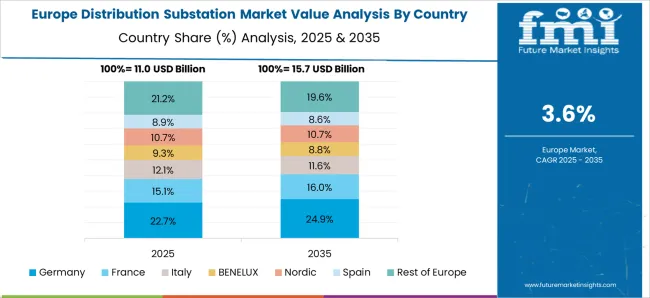
Distribution substation market in Germany is growing at a CAGR of 4.6%. Between 2020 and 2024, growth was supported by renewable energy integration, modernization of power distribution networks, and regulatory compliance. Manufacturers focused on durable, high-performance, and energy-efficient substation equipment for urban and industrial applications. In the forecast period 2025 to 2035, growth is expected to continue steadily with adoption of smart, digital, and IoT-integrated substations enabling predictive maintenance and efficient energy management. Strong regulatory support, renewable energy mandates, and industrial electricity efficiency requirements will further drive adoption. Germany remains a key European market due to advanced power infrastructure, environmental policies, and high industrial electricity demand.
Distribution substation market in the United Kingdom is growing at a CAGR of 3.8%. During 2020 to 2024, adoption was driven by urban electricity demand, expansion of smart grid projects, and modernization of aging infrastructure. Manufacturers focused on reliable, cost-effective, and energy-efficient substation equipment including transformers, switchgears, and monitoring systems. In the forecast period 2025 to 2035, market growth is expected to continue moderately with adoption of digital, IoT-enabled, and energy-optimized substations integrated with renewable sources. Expansion of industrial and residential electricity networks and regulatory compliance will further support market development. The United Kingdom market demonstrates stable growth with focus on reliability, energy efficiency, and advanced distribution technology.
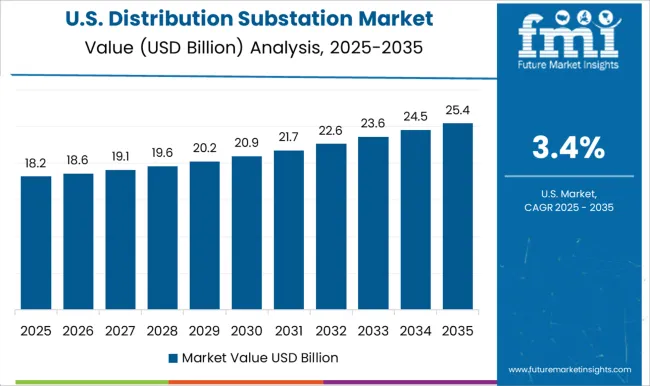
Distribution substation market in the United States is growing at a CAGR of 3.4%. Historical period 2020 to 2024 saw growth fueled by industrial and residential electricity demand, modernization of electrical infrastructure, and renewable energy integration. Manufacturers focused on durable, high-performance, and energy-efficient equipment suitable for substations in urban, industrial, and rural areas. In the forecast period 2025 to 2035, growth is expected to continue steadily with adoption of smart, IoT-integrated, and automated substations enabling predictive maintenance and efficient energy distribution. Expansion of smart grid projects, renewable energy deployment, and regulatory support will further drive market adoption. The United States market demonstrates consistent growth with emphasis on reliability, efficiency, and technological advancement.
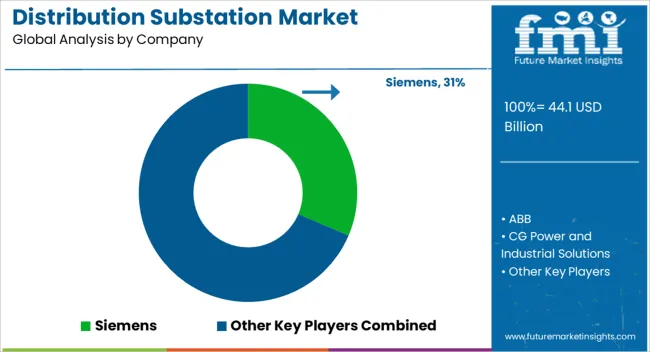
The distribution substation market is supplied by Siemens, ABB, CG Power and Industrial Solutions, Eaton, Efacec, General Electric, Hitachi Energy, L&T Electrical and Automation, Locamation, Open System International, Rockwell Automation, Schneider Electric, Texas Instruments, and Tesco Automation. Competition is driven by system reliability, automation capabilities, safety compliance, and integration with smart grid technologies. Siemens and ABB brochures highlight modular substation solutions with real-time monitoring, protection relays, and digital control interfaces. Eaton and General Electric datasheets emphasize compact designs, low-loss transformers, and scalable automation packages.
Observed industry patterns include deployment of IoT-enabled controls, predictive diagnostics, and advanced SCADA integration. Supplier strategies prioritize digitalization, modular deployment, and service support. Hitachi Energy and Schneider Electric focus on high-voltage and medium-voltage substations with enhanced monitoring and fault detection capabilities. L&T Electrical and Automation and Efacec target utility-scale projects and renewable energy integration with flexible system architecture and maintenance-friendly designs. Rockwell Automation and Open System International provide software and control platforms to enable remote operations, energy optimization, and regulatory reporting. Observed practices include strategic collaborations with utility operators, regional expansions, and investment in engineering services for system customization and performance verification.
Product brochures detail technical specifications including voltage rating, current capacity, switchgear type, protection systems, and environmental tolerance. Siemens and ABB datasheets include insulation levels, breaker ratings, and control panel configurations. Eaton and General Electric provide operational efficiency metrics, fault tolerance parameters, and recommended installation layouts. Schneider Electric and L&T Electrical datasheets emphasize modularity, communication protocol compatibility, and lifecycle maintenance guidelines. Verified technical data allows utilities, project engineers, and procurement teams to select substations that maximize reliability, operational safety, and integration flexibility.
| Item | Value |
|---|---|
| Quantitative Units | USD 44.1 Billion |
| Technology | Digital and Conventional |
| Component | Substation Automation System, Communication Network, Electrical System, Monitoring & Control System, and Others |
| Voltage Level | New and Refurbished |
| Category | New and Refurbished |
| End Use | Utility and Industrial |
| Regions Covered | North America, Europe, Asia-Pacific, Latin America, Middle East & Africa |
| Country Covered | United States, Canada, Germany, France, United Kingdom, China, Japan, India, Brazil, South Africa |
| Key Companies Profiled | Siemens, ABB, CG Power and Industrial Solutions, Eaton, Efacec, General Electric, Hitachi Energy, L&T Electrical and Automation, Locamation, Open System International, Rockwell Automation, Schneider Electric, Texas Instruments, and Tesco Automation |
| Additional Attributes | Dollar sales vary by substation type, including indoor, outdoor, and compact substations; by voltage class, spanning low, medium, and high voltage; by application, such as power distribution, renewable integration, and industrial supply; by end-use, covering utilities, industrial facilities, and commercial establishments; by region, led by North America, Europe, and Asia-Pacific. Growth is driven by increasing electricity demand, grid modernization, and renewable energy expansion. |
The global distribution substation market is estimated to be valued at USD 44.1 billion in 2025.
The market size for the distribution substation market is projected to reach USD 65.3 billion by 2035.
The distribution substation market is expected to grow at a 4.0% CAGR between 2025 and 2035.
The key product types in distribution substation market are digital and conventional.
In terms of component, substation automation system segment to command 42.5% share in the distribution substation market in 2025.






Full Research Suite comprises of:
Market outlook & trends analysis
Interviews & case studies
Strategic recommendations
Vendor profiles & capabilities analysis
5-year forecasts
8 regions and 60+ country-level data splits
Market segment data splits
12 months of continuous data updates
DELIVERED AS:
PDF EXCEL ONLINE
High Voltage Distribution Substation Market Size and Share Forecast Outlook 2025 to 2035
Medium Voltage Distribution Substation Market Size and Share Forecast Outlook 2025 to 2035
Utility Scale Low Voltage Distribution Substation Market Size and Share Forecast Outlook 2025 to 2035
Distribution Board Market Forecast Outlook 2025 to 2035
Distribution Components Market Size and Share Forecast Outlook 2025 to 2035
Distribution Automation Market Size and Share Forecast Outlook 2025 to 2035
Distribution Lines And Poles Market Size and Share Forecast Outlook 2025 to 2035
Distribution Transformers Market Analysis - Size, Share, & Forecast Outlook 2025 to 2035
Distribution Panel Market Size and Share Forecast Outlook 2025 to 2035
Distribution Logistics Market Size and Share Forecast Outlook 2025 to 2035
Cable Distribution Cabinets Market Size and Share Forecast Outlook 2025 to 2035
Power Distribution Component Market Size and Share Forecast Outlook 2025 to 2035
Power Distribution Vacuum Circuit Breaker Market Size and Share Forecast Outlook 2025 to 2035
Power Distribution Unit (PDU) Market Size and Share Forecast Outlook 2025 to 2035
Power Distribution Automation Components Market Analysis by Component, End-Use and Region: Forecast for 2025 to 2035
Hadoop Distribution Market Insights - Trends & Forecast 2025 to 2035
Content Distribution Software Market Size and Share Forecast Outlook 2025 to 2035
Dry Type Distribution Transformer Market Size and Share Forecast Outlook 2025 to 2035
Chemical Distribution Market Size and Share Forecast Outlook 2025 to 2035
Electric Distribution Utility Market Size and Share Forecast Outlook 2025 to 2035

Thank you!
You will receive an email from our Business Development Manager. Please be sure to check your SPAM/JUNK folder too.
Chat With
MaRIA